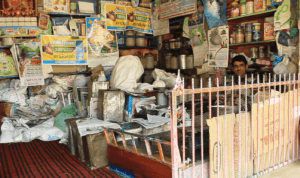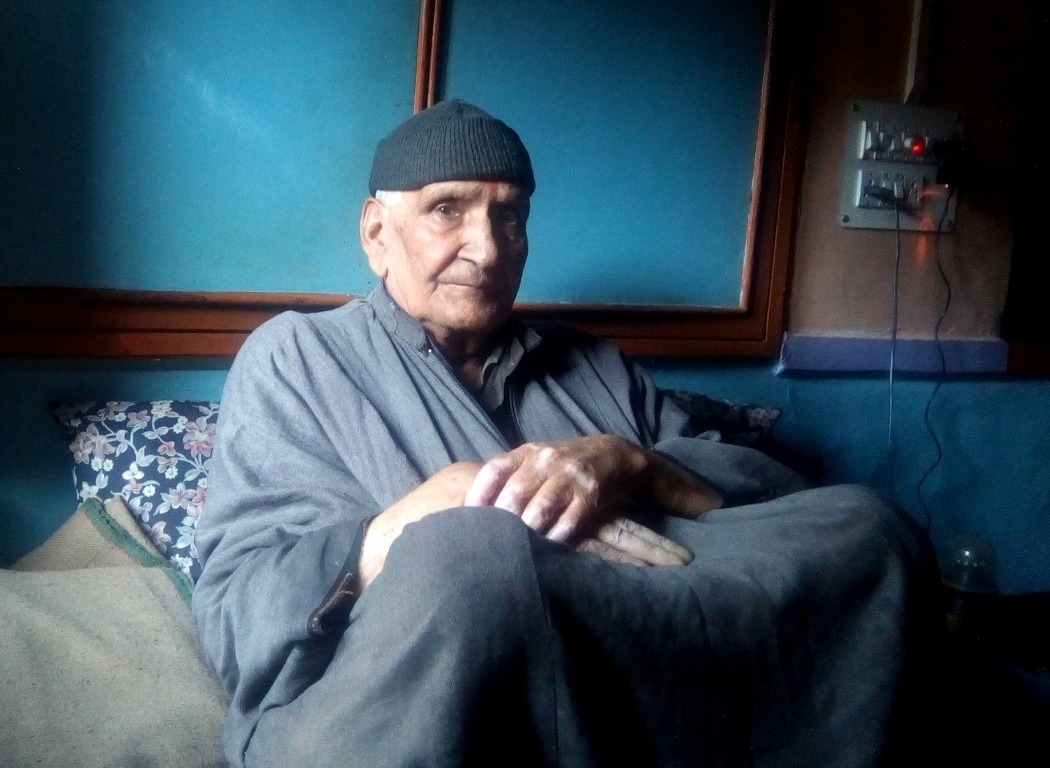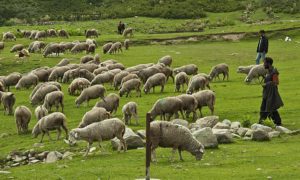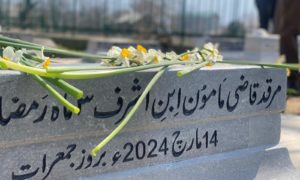Since decades now, swarms of people have been turning up in South Kashmir’s Seer Hamdan to get faith-healing from the non-migrant Kashmiri Pandit family. But the Tickoos are equally respected for curing the critical patients whose families often hear the doctor say: The patient needs prayers rather than pills.
Every morning Muslims, Hindus and Sikhs of different villages and towns queue up to wait for their turn outside the Pandit healer’s infirmary. The walls are pasted with photographs of Hindu Gods and Goddesses, Majid-e-Nabawi, and different shrines of Kashmir Valley. A fervent believer of Dastgeer Sahib, the healer—the peer—is among those Pandits who did not migrate from Kashmir in 1990s.
Wearing a typical Kashmiri greeting face, Somnath Tickoo, 83, lives in the village of Seer Hamdan about 12 kilometers away from Islamabad in South Kashmir.
Sporting a skullcap and pheran, the octogenarian peer looks feeble. He speaks less with restlessness in his movements. In a low voice that struggles to speak, he narrates how his family became the celebrated faith-healers of Seer Hamdan.

“We’ve been healing the sufferers for decades now,” says Somnath, in a panting voice. “I’ve not done any degree in Unani or Ayurvedic medicine. I learnt everything from my father.”
Somnath’s ancestors had opened this infirmary decades ago and were associated with this line of work. As part of the legacy, Somnath stepped into his father’s shoes and rose to become the respectable peer in this part of the world, now synonymous with raging rebellion.
In his postcard village, the villagers speak high of the Pandit Peer.
Most of them have grown up hearing how he managed to heal some acute and chronically ill persons whom the medical science had dismissed as “hopeless cases”.
“Somnath Ji is man of impeccable reputation,” says Mushtaq Dar, his close-door neighbor in Seer Hamdan. “No one can doubt his veracity. He has always revealed his persona through his faith-healing.”
Dar is not alone in acknowledging and admiring the Shafa—faith-healing—of the Pandit Peer, who routinely attends some 50 interfaith patients. His fair treatment with everyone makes him the Peoples Peer.
“Scores of people pay him a visit for treatment,” says Gull Mohammad Hajam, a local villager. “Somnath believes in humanity and has recuperated serious illnesses of some patients. He is famous not only in his own village but in the whole region.”
In the early 1990s, the famous Hakeems of Islamabad like Mustapha Shah of Mattan and Lassa Hakeem of Shangus used to recommend their patients to take medicines from Somnath’s infirmary.
“They were themselves good healers,” says Shadi Lal Tickoo, Somnath’s son, “but they always recommended their patients to our infirmary. They had belief on my father.”
Before 1990, Seer Hamdan was home to some 50 Pandit families. But like other villages and towns of Kashmir then, the local Pandits had to leave the Valley after the armed insurgency began. But the Tickoo family decided to stay put and run their infirmary. Years later, they’re content over their decision.
“We decided to stay and never felt any kind of difficulty in our work even during the peak of armed militancy in Kashmir,” says Shadi Lal.
“My father would regularly treat patients. None stopped or harassed us. Scores of patients used to come to our infirmary for treatment in those days.”

Shaadi Lal Tickoo now runs the infirmary
Inside his room filled with joss stick scent, the elder peer talks about his belief on Sufism and Reshism of Kashmir. He expresses his faith on every shrine of Kashmir, especially Dastgeer Sahib. Like typical Kashmiri Saints, he provides dates and sweetmeats to his visitors. In his moment of respite, he loves to listen to Sufi songs on his radio.
“I’ve also memorized Sufi songs,” says Somnath, singing couplets of a Sufi song. “I often listen to those Sufi Songs in which my Peer-e-Dastgeer has been praised.”
Having a debilitated body and infirmity, Somnath has shouldered responsibility of healing patients on his 40-year-old son, Shadi Lal.
“My father is my mentor,” continues Shadi Lal. “Since 1989, under his supervision, I’ve learnt to write prescription, treating patients and giving direction to them.”
After listening to the problems of patients, Shadi Lal gives them directions and provides them ayurvedic medicines, which he has put in small bottles, stacked up on the shelves, in large jars, and huge buckets scattered in his infirmary in a topsy-turvy way.
Known as Kukaji in Seer Hamdan, the “overwhelming love” makes him emotional.
“The way people treat me really makes me feel that I’m contributing something good to my society,” says Shadi Lal, who has Bachelors degree in Humanities. “Whenever my villagers felt the need of me, they say, ‘Pakh kukji nish shifa khanas peth gasaw’ (Let’s go to Kuka Ji’s infirmary).”
Among the people that have turned up at his infirmary for healing is Mohammad Altaf of village Yaripora, 35km from Seer village.
“My daughter was suffering from serious illness,” says Altaf. “When we heard about Shadi Lal, we immediately visited his infirmary. He prescribed her medicines and gave her directions. Alhamdulillah! She’s now recuperating.”
Shadi Lal’s belief that Allah is the best curer is what guides him through.
“What can an oar do, if Allah doesn’t want the sailor to cross the sea? Similarly how can I heal patients without Allah’s blessing? Allah is the best healer,” he says, pointing his index finger upward.








